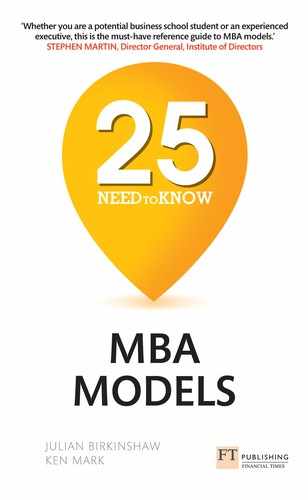Chapter 3
Emotional intelligence
Emotional intelligence is the ability to monitor your own and other people’s emotions. This helps you to discriminate between different emotions and label them appropriately, which in turn helps you to guide your thinking and behaviour and increase your personal effectiveness.
When to use it
- To help you do your job as a manager or a leader of others.
- To decide who to hire or promote.
- To assess and improve the quality of leadership across an organisation.
Origins
The concept of emotional intelligence has been around for many decades. Its origins lie with research done by Edward Thorndike in the 1930s, who came up with the notion of ‘social intelligence’, or the ability to get along with others. In the 1970s Howard Gardner, the educational psychologist, showed that there were multiple forms of intelligence, which helped to legitimise the idea that less academically trained forms of intelligence were important. The term ‘emotional intelligence’ was first used by researcher Wayne Payne in 1985, in his doctoral dissertation.
Since then, three different approaches to emotional intelligence have emerged. The ability model of Peter Salovey and John Mayer focuses on the individual’s ability to process emotional information and use it to navigate the social environment. The trait model of K.V. Petrides focuses on an individual’s self-perceived attributes – it sees emotional intelligence as a set of human traits. The third and most popular approach, put forward by author Daniel Goleman, is a blend of the other two, in that it combines abilities and traits.
What it is
There are many different types of human intelligence – some people are good at mathematics, some are good with words, others have musical skills or good hand–eye coordination. Emotional intelligence is one such type of intelligence. It is very hard to measure, but it turns out to be vitally important in the workplace, and especially for leaders of organisations. One of the hallmarks of great leaders, it is argued, is that they are good at sensing how others are feeling, and adapting their message and their style of interaction accordingly. Great leaders are also very aware of their own strengths and weaknesses, which is another important facet of emotional intelligence.
The popular model of emotional intelligence put forward by Daniel Goleman concentrates on five components:
- Self-awareness: the ability to recognise and understand personal moods and emotions and drives, and their effect on others.
- Self-regulation: the ability to control disruptive impulses and moods, suspend judgement and think before acting.
- Internal motivation: a passion to work for internal reasons that go beyond money and status.
- Empathy: the ability to understand the emotional make-up of other people.
- Social skills: proficiency in managing relationships and building networks, finding common ground and building rapport.
How to use it
You can use the concept of emotional intelligence in an informal or a formal way.
The informal way is to reflect on Goleman’s five traits as desirable attributes that you or others should have. Do you think you are self-aware? Do you have strong empathy and social skills? This sort of casual analysis can lead to useful insights about things you might do differently, or the type of training course you might want to take.
The formal way is to use the official diagnostic surveys created by academics. John Mayer, one of the originators of the concept, says ‘In regard to measuring emotional intelligence – I am a great believer that [ability testing] is the only adequate method to employ’.
There are several different surveys available. ‘EQ-I’ is a self-report test designed by Reuven Bar-On to measure competencies including awareness, stress tolerance, problem solving and happiness. The ‘Multifactor Emotional Intelligence Scale’ gets test-takers to perform tasks based on their ability to perceive, identify and understand emotions. The ‘Emotional Competence Inventory’ is based on ratings from colleagues on a range of emotion-based competencies.
Top practical tip
Emotional intelligence is, by nature, very hard to measure. We would all like to think we are emotionally intelligent, but we aren’t! So the top practical tip is to get multiple points of view. Sometimes you do this through anonymous feedback and sometimes through group-based coaching sessions, where people give each other candid feedback.
Top pitfalls
The problem with a concept such as emotional intelligence is that it sounds so alluring that everyone wants it. However, it takes a lot of time to change your own way of working and how you relate to others. So the biggest pitfall is to think that being assessed and understanding how emotionally intelligent you are is the end-point. In fact, this is really just the starting point, because it is then that the hard work of making changes begins. Typically, you cannot do this on your own – you need a helpful boss or colleague, or personal coach.
Another pitfall is to misuse emotional intelligence as a way of manipulating others. For example, if you have a really good understanding of how your personal style affects others, you might be able to lure them into doing something they didn’t really intend to do. There is a fine line between being skilful and being manipulative, and it is important not to overstep that line.
Further reading
Goleman, D. (2006) Emotional Intelligence: Why it can matter more than IQ. New York: Random House.
Grant, A. (2014) ‘The dark side of emotional intelligence’, The Atlantic, 2 January.
Petrides, K.V. and Furnham, A. (2001) ‘Trait emotional intelligence: Psychometric investigation with reference to established trait taxonomies’, European Journal of Personality, 15(6): 425–448.
Salovey, P., Mayer, J. and Caruso, D. (2004) ‘Emotional intelligence: Theory, findings, and implications’, Psychological Inquiry, 15(3): 197–215.
